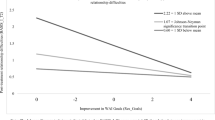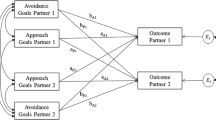Abstract
This study examined the relations between interpersonal conflict, interpersonal problem solving, and internalizing symptoms (viz., depression and anxiety symptoms) in a sample of 123 college students. Conflict was assessed in five different close relationships (viz., best friend, second best friend, romantic partner, mother, father). In addition, five dimensions of problem-solving ability were examined (viz., positive and negative problem orientation, rational problem solving, impulsivity/carelessness style, avoidance style). Regression analyses showed negative problem orientation to predict depression above and beyond what was accounted for by mother conflict and romantic conflict. Avoidance style was also found to predict depression beyond what was accounted for by mother conflict alone. Negative problem orientation was also found to be a highly significant moderator of the relationship between romantic partner conflicts and anxiety symptoms. Specifically, the relationship between conflicts and anxiety symptoms was stronger when negative problem orientation was high rather than low. Implications for theory, clinical practice, and future research are discussed.
Similar content being viewed by others
References
Bandura, A. (1986). Social foundations of thought and action: A social cognitive theory. Upper Saddle River, NJ: Prentice-Hall.
Baron, R. M., & Kenny, D. A. (1986). The moderator-mediator variable distinction in social psychological research: Conceptual, strategic, and statistical considerations. Journal of Personality and Social Psychology, 51, 1173–1182.
Beach, S. R., Nelson, G. M., O’Leary, K. D. (1988). Cognitive and marital factors in depression. Journal of Psychopathology & Behavioral Assessment, 10, 93–105.
Beach, S. R., Sandeen, E., & O’Leary, K. D. (1990). Marital discord model of depression. In Depression in Marriage (pp. 53–84). New York: Guilford.
Beck, A. T., Epstein, N., Brown, G., & Steer, R. (1988). An inventory for measuring clinical anxiety: Psychometric properties. Journal of Consulting and Clinical Psychology, 56, 893–897.
Beck, A. T., & Steer, R. A. (1987). Beck Depression Inventory manual. San Antonio, TX: Psychological Corporation.
Beck, A. T., & Steer, R. A. (1993). Beck Anxiety Inventory manual. San Antonio, TX: Psychological Corporation.
Beck, A. T., Steer, R., & Garbin, M. (1988). Psychometric properties of the Beck Depression Inventory: 25 years of evaluation. Clinical Psychology Review, 8, 77–100.
Beck, A. T., Ward, C. H., Mendelson, M., Mock, J. E., & Erbaugh, J. K. (1961). An inventory for depression. Archives of General Psychiatry, 4, 561–571.
Berndt, T. J. (1992). Friendship and friends’ influence in adolescence. Current Directions in Psychological Science, 1, 156–159.
Biglan, A., Hops, H., Sherman, L., Friedman, L. S., Arthur, J., & Osteen, V. (1985). Problem-solving interactions of depressed women and their husbands. Behavior Therapy, 16, 431–451.
Black, K. A. (2002). Associations between adolescent-mother and adolescent-best friend interactions. Adolescence, 37, 235–254.
Christensen, A., & Shenk, J. L. (1991). Communication, conflict, and psychological distance in non-distressed, clinic, and divorcing couples. Journal of Consulting & Clinical Psychology, 59, 458–463.
Davila, J. (2001a). Paths to unhappiness: The overlapping courses of depression and romantic dysfunction. In R. H. Beach (Ed), Marital and family processes in depression: A scientific foundation for clinical practice (pp. 71–87). Washington, DC: American Psychological Association.
Davila, J. (2001b). Refining the association between excessive reassurance seeking and depressive symptoms: The role of related interpersonal constructs. Journal of Social Clinical Psychology, 4, 538–559.
Davila, J., & Beck, J. G. (2002). Is social anxiety associated with impairment in close relationships? A preliminary investigation. Behavior Therapy, 33, 427–446.
Davila, J., Hammen, C., Burge, D., Daley, S. E., & Paley, B. (1996). Cognitive/interpersonal correlates of adult interpersonal problem-solving strategies. Cognitive Therpay and Research, 20, 465–480.
Davila, J., Karney, B. R., Hall, T. W., & Bradbury, T. N. (2002). Depressive symptoms and marital satisfaction: Within-subject associations and the moderating effects of gender and neuroticism. (in press).
Dixon, W. A., Heppner, P. P., & Rudd, M. D. (1994). Problem-solving appraisal, hopelessness, and suicide ideation: Evidence for a mediational model. Journal of Couseling Psychology, 41, 91–98.
D’Zurilla, T. J., Chang, E. G., & Sanna, L. J. (2004). Social problem-solving: Current status and future directions. In E. G. Chang, T. J. D’Zurilla, & L. J. Sanna, (Eds.), Social problem solving: Theory, research, and training. Washington, D.C.: American Psychological Association.
D’Zurilla, T. J., Nezu, A. M. (1982). Social problem-solving in adults. In P. C. Kendall (Ed.), Advances in cognitive-behavioral research and therapy (Vol. 1, pp. 201–274) New York: Academic Press.
D’Zurilla, T. J., & Nezu, A. M. (1990). Development and preliminary evaluation of the Social Problem-Solving Inventory (SPSI). Psychological Assessment: A Journal of Consulting and Clinical Psychology, 2, 156–163.
D’Zurilla, T. J., & Nezu, A. M. (1999). Problem-solving therapy: A social competence approach to clinical intervention (2nd ed.). New York: Springer.
D’Zurilla, T. J., Nezu, A. M., & Maydeu-Olivares, A. (2002). Social problem-solving inventory-revised: Technical manual. North Tonawanda, NY: Mental Health Systems, Inc.
D’Zurilla, T. J., Nezu, A. M., & Maydeu-Olivares, A. (2004). Social problem solving: Meanings, models, and measures. In E. G. Chang, T. J. D’Zurilla, & L. J. Sanna, (Eds.), Social problem solving: Theory, research, and training. Washington, D.C.: American Psychological Association.
Frye, A. A., & Goodman, S. H. (2000). Which social problem-solving components buffer depression in adolescent girls? Cognitive Therapy and Research, 24, 637–650.
Gotlib, I. H., & Beach, S. R. H. (1995). A marital/family discord model of depression: Implications for therapeutic intervention. In N. S. Jacobson and A. S. Gurman, (Eds.), Clinical handbook of couple therapy (pp. 411–436). New York: Guilford Press.
Haaga, D. A., Fine, J. A., Terrill, D. R., Stewart, B. L., & Beck, A. T. (1995). Social problem-solving deficits, dependency, and depressive symptoms. Cognitive Therapy and Research, 19, 147–158.
Heppner, P. P. (1988). The problem solving inventory: Manual. Palo Alto, CA: Consulting Psychologists Press, Inc.
Holmbeck, G. N. (1997). Toward terminological, conceptual, and statistical clarity in the study of mediators and moderators: Examples from the child-clinical and pediatric psychology literatures. Journal of Consulting and Clinical Psychology, 65, 599–610.
Inderbitzen, H. M., Walters, K.S., & Bukowski, A. L. (1997). The role of social anxiety in adolescent peer relations: Differences among sociometric status groups and rejected subgroups. Journal of Clinical Child Psychology, 26, 338–348.
Jacobson, N. S., & Margolin, G. (1979). Marital therapy: Strategies based on social learning and behavioral exchange principles. New York: Brunner/Mazel.
Jensen-Campbell, L. A., & Graziano, W. G. (2000). Beyond the school yard: Relationships as moderators of daily interpersonal conflict. Personality and Social Psychology Bulletin, 26, 923–935.
Kant, G. L., D’Zurilla, T. J., & Maydeu-Olivares, A. (1997). Social problem-solving as a mediator of stress-related depression and anxiety in middle-aged and elderly community residents. Cognitive Therapy and Research, 21, 73–96.
La Greca, A. M., & Lopez, N. (1998). Social anxiety among adolescents: Linkages with peer relations and friendships. Journal of Abnormal Child Psychology, 26, 83–94.
Laursen, B., & Collins, W. A. (1994). Interpersonal conflict during adolescence. Psychological Bulletin, 115, 197–209.
Londahl, E. A., Tverskoy, A., & D’Zurilla, T. J. (2002). Correlations between the scales of the SPSI-R:I and the SPSI-R:SI. Unpublished data, Department of Psychology, Stony Brook University.
McCabe, R. E., Blankstein, K. R., & Mills, J. S. (1999). Interpersonal sensitivity and social problem-solving: Relations with academic and social self-esteem, depressive symptoms, and academic performance. Cognitive Therapy and Research, 23, 587–604.
Miner, R. C., & Dowd, E. T. (1996). An empirical test of the problem solving model of depression and its application to the prediction of anxiety and anger. Counseling Psychology Quarterly, 9, 163–179.
Nezu, A. M., & D’Zurilla, T. J. (1989). Social problem solving and negative affective conditions. In P. C. Kendall and D. Watson (Eds.), Anxiety and depression: Distinctive and overlapping features (pp. 285–315). New York: Academic Press.
Nezu, A. M., D’Zurilla, T. J., Zwick, M. L., & Nezu, C. M. (2004). Problem-solving therapy for adults. In E. G. Chang, T. J. D’Zurilla, & L. J. Sanna, (Eds.), Social problem solving: Theory, research, and training. Washington, D.C.: American Psychological Association.
Nezu, A. M., & Ronan, G. F. (1988). Problem solving as a moderator of stress-related depressive symptoms: A prospective analysis. Journal of Counseling Pscyhology, 35, 134–138.
Sabourin, S., Laporte, L., & Wright, J. (1990). Problem solving self-appraisal and coping efforts in distressed and nondistressed couples. Journal of Marital and Family Therapy, 16, 89–97.
Sobel, M. E. (1982). Asymptotic intervals for indirect effects in structural equations models. In S. Leinhart (Ed.), Sociological methodology 1982 (pp. 290–312). San Francisco: Jossey-Bass.
Tverskoy, A., Londahl, E. A., & D’Zurilla, T. J. (2003). Conflict and problem solving in close relationships and their relations to aggression. Manuscript submitted for publication, Department of Psychology, Stony Brook University.
Walker, L. O., & Johnson, L. B. (1986). Preschool children’s socio-emotional development: endogenous and environmental antecedents in early infancy. Final report to the Hogg Foundation for Mental Health. As cited in Heppner, P. P. (1988). The problem solving inventory: Manual. Palo Alto, CA: Consulting Psychologists Press, Inc.
Weiss, R. L., & Heyman, R. E. (1997). A clinical-research overview of couples interactions. In W. K. Halford & H. J. Markman, (Eds.), Clinical handbook of marriage and couples interventions (pp. 13–41). Queensland, Australia: Wiley.
Author information
Authors and Affiliations
Corresponding author
Rights and permissions
About this article
Cite this article
Londahl, E.A., Tverskoy, A. & D’Zurilla, T.J. The Relations of Internalizing Symptoms to Conflict and Interpersonal Problem Solving in Close Relationships. Cogn Ther Res 29, 445–462 (2005). https://doi.org/10.1007/s10608-005-4442-9
Issue Date:
DOI: https://doi.org/10.1007/s10608-005-4442-9




